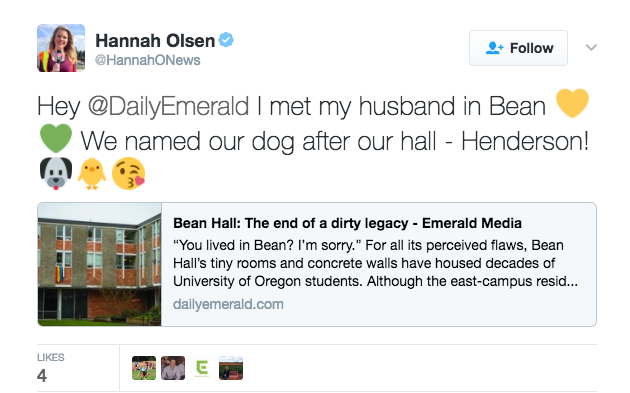By: Mark Kellman (@MarkKellman)
What are University of Oregon college student most passionate about? Puppies, alcohol and sports. How do I know this? Let’s find out.
For over two years, social media has been my life. I hear things and learn things on social media all day, every day. As the engagement editor for the Daily Emerald, I look into the reach and engagement on every social post. I need to know what did well, what didn’t and why.
Examining insights and analytics on Facebook and Twitter can send you down a very confusing rabbit hole. Facebook, in particular, offers you so much information on your audience, it feels like the ultimate form of stalking. It feels like you know too much information about people you may never meet.
For Instance, I know our audience is primarily women between the ages of 18 and 26. I also know their hometowns and current cities. I see what countries people are in around the world that view our page. All of this information and more helps decide what articles to push everyday.
Each person that works for the Emerald, is also the target demographic. This doesn’t always happen in a company. So I pose this question to every new producer I hire: What engages you? What makes you like a page? If a post doesn’t interest the person writing it, why would it interest anyone else?
These seem like rhetorical questions, but they’re important to think about every time a producer schedules a post. In addition, it reminds people who they are trying to reach on a daily basis.
Know your audience and take advantage of them
You can learn a lot about people without ever talking to anyone. It never ceases to amaze me stories that do well. College students are an exceptional group of homogenous, predictable people. Post an article with a feature image of an adorable puppy and you will break engagement records for the entire year. Post an investigative piece a reporter worked on for two weeks and maybe 1,000 people will see it. Over time at the Emerald, I can now predict with accuracy which articles will thrive, post an average reach and those that we should avoid posting all together.
Our best article of this week was the cover story from Thursday about Bean Hall and the impending renovation this summer. People loved the story. For example On Twitter we had a user reply to the story that she met her husband in Bean and on Facebook almost 100 people commented and tagged friends reminiscing about how they survived living in Bean. Articles like this do well because it has depth, it appeals to past and present Ducks and we know they care about the issue.


With statistics to back me up, I know exactly what college students are interested in: puppies, alcohol and sports. If we can, I try to post as many stories that our audience is interested in as possible to increase the following of the Daily Emerald.
New Challenges
This is the biggest challenge that journalists face in the age of social media. If people can select exactly what they want to read, why not give them exactly what they want? We know that Facebook is more likely to show you articles on your feed it knows you’ll like and click on. Presenting a post that might challenge someone’s views is now more difficult than ever to get someone to see.
With that, do we only focus our resources on articles that are sure to do well? How do journalists find a balance of hard-hitting investigative pieces and easy posts that we already know with certainty will do well? It’s a daily conversation in the newsroom and no one really knows the answer yet. What do you think?




Mark,
Thanks for this thought provoking blog. I have to admit, I clicked on this to read because of the puppy in the photo. I think you bring up a lot of good points–I am very fearful of people on Facebook only seeing the content that they want to see or that validates their opinion. I see it happening with myself–my news feed is full of people just like me, and thinking like me. And if there is anything that I see that I disagree with, it’s probably because someone I am friends with commented on the post to debate that post in defense of “our” opinion. It is a self-perpetuating cycle that closes our minds.
In my opinion, when a journalist or social media content manager can figure out how to drive traffic while still telling a captivating story that makes people truly think about a situation holistically instead of immediately wanting to say “yes, I agree with this wholeheartedly” or “no, that is completely wrong,” then they have found the sweet spot. I do feel like it is possible to create content that is both interesting enough to draw eyeballs and thought provoking enough to add some sort of intellectual/critical thinking value to the reader. This might mean doing things differently than before.
The Skimm is an interesting, innovative model as it relates to the news. They talk about a ton of different issues in short bits that are digestable for readers, but also provide more in-depth resources for those that want it. But if you don’t want to read a whole article, you aren’t committing yourself to that. It would be interesting to know how the Skimm defines success in terms of traffic. As a reader, I find their service incredibly valuable and helpful to me. Even though I’m a graduate student now, I used to coach at the collegiate level and one of the things that I quickly learned about undergrads was how concerned they always were about their busy schedules. It seems like your target audience might benefit from some kind of a briefing (which looks like you do with the podcast, but maybe that is even too time consuming?).
Thanks again for the post. Interesting Read.
-Lauren
Hey Mark, great blog post!
As a part of the engagement team at the Emerald, I feel the pain of seeing great articles not doing well on Facebook and Twitter. As college students, we have a short attention span and are only interested in articles that pertain to our interest and are a quick read. So how do we as social media producers help conquer that problem? Social media is the best tool to engage an audience such as college students. I have learned to keep posts short and sweet, add humor and ask questions when appropriate. All of the articles that the Emerald are important, or we wouldn’t be posting them but only some are very interesting. I think that college media groups need to realize that the core audience is interested in juicy gossip or a breaking news story but the small articles about what the ASUO is doing are important too.
What a great blog title. I picked this to read exclusively because I wanted to know what three things college students care about. I am starting to dive more into social media for my work and I am jealous of your experience and comfortability with data and how it drives posts. It totally makes sense, it is just a whole new world for me and I am learning so much!
I thought it was really interesting that you categorized your viewer’s top interest by “Puppies, alcohol, and sports.” Could you also consider that more broadly the categories could be, tear-jerking stories, and college drinking culture? You hit the nail on the head about sports, Ducks love nothing more than Duck Sports. I don’t follow the Daily Emerald all that much, but I did see all of the engagement with Bean Hall. I never expected it to have this kind of response.
I think the points you made were interesting. Facebook does give you a ton of information and data to sift through. Stalking is something that is very easy to do on Facebook and the tools they provide for pages make the possibilities even greater.
Thanks for your insight, I would love to swap social media strategies sometime soon.
Mark,
Thank you so much for your insight on this topic. I loved the categories that you split the engagement into because I really feel like the tagline “puppies, alcohol and sports” really helped draw readers in. I follow the Daily Emerald on a lot of social media and have seen the engagement with this type of content on their sites. I think that it was super interesting that you dove specifically into Facebook usage and engagement because I really feel a lot about how the Daily Emerald uses their social media. I also really enjoyed that you posed questions for what is next in the world of social media for companies because they are questions that I ask myself a lot because I am interested in running corporate social media one day.
I loved this blog post! As an employee on the business side of the Emerald Media Group, I see the exact same things with our branding and marketing efforts. Puppies, alcohol, and sports. Could not be more accurate. Your insight was great, and I could not agree more. I found it interesting that you mentioned the target audience of the Daily Emerald being women ages 18-26, and that you know exactly what this demographic wants to see. I have never felt so predictable in my life, because as a 21-year-old female, this type of content in exactly what gets me, without fail every single time. For example, I absolutely chose to read your blog post due to the photo of the puppy. I saw the engagement the Emerald got with the story of the abandoned puppy, and I imagine it was one of the more sought out articles the Daily Emerald has ever put out.
I loved your insight, hope to see you around the Emerald soon!
Mark,
It looks like you’ve learned a lot from your job at the Daily Emerald. For instance, I clicked on this blog post because the featured image is of a puppy! As a student, it’s interesting to see what Emerald stories get popular among my friends. Stories about puppies (the abandoned puppy story), alcohol (the two Taylor’s crises) and sports (any stories about football) ended up growing immensely popular, just like you said.
I also appreciate that you addressed the issue of credible journalism and social media. How can journalists remain unbiased and create content that people will read at the same time? The lines between journalism and social media are starting to blur. I’m excited to see what the future holds!
Erin
Mark- this is a really good read. You are pretty spot on in your claim that college students are most interested in sports, alcohol, and puppies. The title of your blog is perfect; it pulls the reader in due to the fact that it is a bold statement. I sure thought, “Wait a minute, how is he going to make such a generalization?” Also, the type of work you do for the Daily Emerald includes the skills sets that all of us need to adopt for our professional lives. That type of practice and repetition on social media analysis is something I hope to perfect throughout the remainder of college.
Nice post!
Have you done any investigating into whether this differs between undergraduate students and students pursuing their masters degree? I definitely do still really really like puppies, alcohol, and sports… I am in a sports marketing program and puppies and the occasional bubbly provide a solid release from the grips of #gradstudentlife. Though I would like to believe as a graduate student my peers and I have a greater depth of interests when it comes to journalism and choosing which content to consume. BUT I could be totally wrong! Is the entire world only interested in puppies, alcohol and sports? I could see it actually…
I thought this was an incredibly interesting post! To be honest, when I see posts from the Daily Emerald if the title does not interest me, I just skip over them. These posts that do not interest me are probably the articles that you spend weeks on and only get 1000 views. But when I saw the puppy article I clicked on it right away, shared it, and tagged my friends in it. Everyone loves puppies! And everyone hates people who abandon puppies. It is almost sad that there are people like me who just read articles when they have to do with puppies or alcohol or sports. It is true that people love drama, and reading about people whose lives are worse than their own. So how do you figure out what attracts certain people? And how do you get more people to read your articles? This was very informative!!
The post title definitely caught my attention. I am always interested in how much engagement the Emerald actually receives in terms of on social media and through the printed newspapers. I can definitely see how some articles would do better than another and I do think it is directly connected what students (your audience) cares about. People tend to care more about things that directly impact them in some way or if they gain something from it and it seems like analytics show that. However, I do think at least some part of the student body is interested in every article that is written in the Emerald!
Very cool topic to write about Mark! It’s funny that you write how these are the most important things to college students because I don’t think anyone realizes how deep this discovery runs. Tracking each and every mention, like, favorite etc. can be the most tiring and tedious to exist. People’s attention spans are so short that if the photo and/or title of an article doesn’t relate to them then it won’t even be skimmed over. I think this brings up an important note for businesses to take into consideration when thinking of how to boost their reader engagement!
Mark, I enjoyed the catchy title of this article because it drew me to think what specifically you might be talking about. Of everything in college, what specific three things could you come up with? The three things mentioned definitely were a little expected with one in particular more scary accurate than the others. I found it interesting on the one section labeled “know you audience and take advantage of them.” I really enjoyed that you brought your work into this blog post because you have a little more college insight working for the college newspaper. I agree when you mentioned you can find out a lot about a person without ever talking to them. It is freaky to think but it is so easy to know someone’s name and instantly figure out where they are from and a few interests by checking Facebook. Even a step further that you now have statics to back up your three things that college students are into was scary true. At our school in particular I agree with sports being the third but just from research alone to find even more specifically puppies is interesting. I would be intrigued to find out 10 years from now if the three things change or remain the same. A great thought provoking blog post definitely.
Mark,
The feature image of a puppy definitely caught my attention. But I’m glad it did because it led me to reading your post that has helped me with my own post on influencers for class. Why would I write about something that wouldn’t even interest me? That’s when I sprinkled some of my own magic into the post by adding a section on a brand that interests me while talking about influencers.
It was very interesting to read about your job as an engagement director for the Daily Emerald. I follow the Daily Emerald on social media and it’s true, I would only click on a post if it involves a puppy, alcohol (such as the new post on 10 do’s and don’ts of campus barhopping), or UO sports. I definitely agree that to drive more conversation and gain more views on posts, you have to know your audience. Keep up the good work!
A good, yet tragic, article. How sad it is that journalists have to wave candy (or puppies) in the air to attract the attention of COLLEGE students like children in a ball pool. And it certainly is not just college students – adults, too, are being constantly distracted by bright, shiny things to the detriment of understanding real issues (note the current WH), real journalistic research/integrity and things that will really impact their futures. As the bar lowers to frightening levels, journalists who speak the truth have less impact than what one Kardashian said about another Kardashian. What’s the solution? Education, an increased attention span and the promotion of real, public media not funded by obvious politically motivated money. We are reaching (have reached?) a tipping point where unless smart people start pushing a smart agenda across the socio-political spectrum, we really will be living out the Idiocracy movie – and it won’t be a comedy 🙂